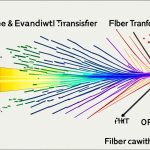The growth of the internet is driving the demand for higher bandwidth in optical fiber communication networks. Online commerce, mobile applications, video-on-demand, cloud computing, and other services are contributing to a 30% annual growth rate. This growth is projected to continue, with traffic expected to grow by a factor of 10-100 times between 2020 and 2030. To meet this demand, advancements in coherent optical communication technology are crucial.
Coherent optical communication technology offers the potential for significant improvements in long-haul networks. These networks are responsible for transmitting data over vast distances, connecting cities and regions. The ability to efficiently transmit data across these long-haul links is essential for maintaining the performance and reliability of the internet.
Over the years, various advancements have been made in coherent optical communication, enabling higher data rates, increased transmission reach, and improved signal quality. These advancements have been instrumental in keeping up with the ever-growing demand for bandwidth.
In this article, we will explore the latest advancements in coherent optical communication for long-haul networks. From the increasing need for higher bandwidth to the transformative benefits of sixth-generation optics, we will delve into the technologies and solutions that are shaping the future of long-haul communication.
The Bandwidth Demand
The internet’s annual growth rate of 30% is fueled by various factors such as online commerce, mobile applications, video-on-demand, cloud computing, and social media. This relentless growth has created an unprecedented demand for higher bandwidth in optical fiber communication networks. These networks form the backbone of the internet, enabling quick, low-cost, and reliable communication for users around the globe.
In line with this exponential growth, the number of Internet-connected devices is projected to be three times the global population by 2023. This staggering increase in connected devices necessitates a significant increase in bandwidth capacity to support seamless connectivity and the exchange of vast amounts of data.
The Role of Optical Fiber Communication
Optical fiber communication plays a crucial role in meeting the bandwidth demand of the internet-driven world. With its ability to transmit data over long distances at high speeds, optical fiber has become the preferred medium for long-haul and high-capacity communication networks. It offers numerous advantages over traditional copper-based networks, including higher data transfer rates, immunity to electromagnetic interference, and greater reliability.
Internet Growth and Connectivity
The growth in mobile connectivity is another significant driver of the bandwidth demand. With the advent of 5G networks and the increasing popularity of mobile applications, mobile connectivity has become an integral part of our daily lives. It is estimated that over two-thirds of the world population will be connected to the internet by 2025, thanks to the proliferation of affordable smartphones and improved network infrastructure.
The Need for Higher Bandwidth
The demand for higher bandwidth in optical fiber communication networks is fueled by the increasing reliance on data-intensive applications and services. Online commerce, video streaming platforms, cloud-based applications, and social media platforms require fast and reliable internet connections to deliver a seamless user experience. Additionally, emerging technologies such as virtual reality, augmented reality, and the Internet of Things (IoT) further contribute to the need for higher bandwidth.
To illustrate the scale of the bandwidth demand, let’s take a look at some statistics:
| Year | Global Internet Traffic |
|---|---|
| 2020 | 193 exabytes per month |
| 2025 | 406 exabytes per month |
| 2030 | 2,000 exabytes per month |
The table above showcases the projected growth in global internet traffic over the next decade. By 2030, the bandwidth demand is expected to increase by a factor of 10-100 times compared to 2020. These staggering numbers emphasize the critical need for advancements in optical fiber communication technology to meet the ever-increasing demand for higher bandwidth.
Connectivity in Short-Reach
Optical networks play a crucial role in enabling efficient and high-speed communication. These networks can be classified based on various factors, including reach, capacity, topology, and cost. In this section, we will focus on short-reach optical communications, which cater to transmission distances ranging from 300m to 100km. Short-reach networks are extensively used in very short-reach, access, and metropolitan area networks, providing connectivity in densely populated areas.
Short-reach optical communications utilize different network topologies to ensure efficient data transfer. Some common topologies include:
- Point-to-point: This topology connects two devices or locations directly, allowing for dedicated and secure communication.
- Passive broadcast: In this topology, a central point broadcasts data to multiple receiving points without the need for active devices.
- Ring: A ring topology forms a closed loop, enabling data transmission in both directions, ensuring redundancy and fault tolerance.
Short-reach optical communications are a leading market segment, driven by the need for high throughput, low latency, small footprint, and low power consumption at an affordable cost. These networks form the backbone of various applications, facilitating seamless connectivity in industries such as telecommunications, data centers, and smart cities.
To further understand the significance of short-reach optical communications, let’s take a closer look at an example network topology:
| Topology | Advantages | Disadvantages |
|---|---|---|
| Point-to-Point | Secure and dedicated connection | Higher cost for multiple connections |
| Passive Broadcast | Efficient data distribution | Weakens signal over larger distances |
| Ring | Redundancy and fault tolerance | Single point of failure |
Technical Considerations in Short-Reach Optical Communications
When designing short-reach optical networks, several technical factors need to be considered to ensure optimal performance:
- Transmission Distance: Short-reach networks are designed to cater to specific transmission distances, usually up to 100km. The chosen network topology should support the required distance without signal degradation.
- Bandwidth Requirements: Short-reach networks must have the capability to handle high-bandwidth demands, such as those generated by data-intensive applications.
- Latency: Low latency is crucial in applications where real-time data transfer is critical, such as video streaming or teleconferencing.
- Footprint: Short-reach networks are often deployed in compact spaces such as data centers or metropolitan areas. Therefore, network equipment should have a small physical footprint to optimize space utilization.
- Power Consumption: Energy efficiency is a key consideration in short-reach networks to minimize operating costs and contribute to environmental sustainability.
By addressing these technical considerations, short-reach optical communications can provide reliable, high-speed connectivity across various industries, driving digital transformation and fostering innovation.
Bridging the Gap: Balancing Cost and Performance with Self-Coherent Technology
Coherent detection plays a pivotal role in short-reach optical links, delivering high-performance data transmission. However, it comes at a significant cost. To address the cost-performance gap, a more cost-effective solution lies in intensity modulation and direct detection (IM/DD). By leveraging IM/DD technology, network operators can achieve a balance between cost and performance, meeting the demands of data-intensive applications.
When it comes to data rate and transmission reach, fiber chromatic dispersion (CD) and attenuation impose limitations. Coherent detection, combined with digital pre- and post-electronic dispersion compensation (EDC), effectively overcomes the challenges posed by fiber CD, enabling longer transmission distances. On the other hand, direct detection relies on complex nonlinear equalization techniques to compensate for both linear and nonlinear distortions.
“IM/DD provides a cost-effective alternative to coherent detection while maintaining the desired performance levels. By exploring the benefits of IM/DD technology, network operators can realize significant cost savings without compromising on data transmission quality.”
Coherent technology remains essential for long-haul networks, where performance optimization is critical. However, for short-reach optical links, embracing IM/DD offers a cost-effective approach that aligns with the growing demand for high-speed data transmission.
Advantages of IM/DD Technology:
- Cost-effective solution compared to coherent detection
- Enables transmission over longer distances
- Mitigates fiber chromatic dispersion through digital dispersion compensation
- Compatible with existing network infrastructure
- Facilitates seamless integration with performance optimization techniques
| Coherent Detection | Intensity Modulation and Direct Detection (IM/DD) |
|---|---|
| Expensive | Cost-effective |
| Overcomes fiber chromatic dispersion | Requires complex nonlinear equalization |
| Enables advanced performance optimization techniques | Compatible with existing network infrastructure |

With IM/DD technology, network providers can achieve cost-effective solutions without compromising performance. The compatibility with existing network infrastructure also ensures a smooth integration process. By adopting this approach, network operators can meaningfully bridge the cost-performance gap and unleash the full potential of short-reach optical links.
Advancements in Coherent Optical Communication
Advances in digital signal processing (DSP) have revolutionized coherent optical communication. DSP-based phase and polarization management techniques make coherent detection robust and practical. Coherent detection allows for the complete recovery of the complex field of the received signal, enabling compensation of linear impairments such as chromatic dispersion and polarization-mode dispersion using digital filters. Furthermore, fiber nonlinearities can be compensated through backward propagation in the digital domain.

These advancements in coherent optical communication have significantly improved signal quality and transmission performance. By applying sophisticated DSP algorithms, it is now possible to achieve accurate and reliable transmission over long-haul networks.
Complex Field Recovery Through Coherent Detection
Coherent detection plays a crucial role in the recovery of the complex field of the received signal. It allows for the extraction of both the amplitude and phase information, which is essential for compensating various impairments in the optical channel.
“Coherent detection enables the extraction of the full complex field of the received signal, facilitating the compensation of linear impairments and nonlinearities through advanced DSP algorithms.”
By using digital filters in the DSP stage, it is possible to minimize the impact of chromatic dispersion and polarization-mode dispersion, which are common sources of signal degradation in optical communication systems.
Backward Propagation for Compensation of Nonlinearities
In addition to compensating linear impairments, DSP-based coherent optical communication also enables the compensation of fiber nonlinearities. By leveraging backward propagation algorithms in the digital domain, these nonlinear effects can be effectively mitigated.
“Through backward propagation, coherent optical communication systems can compensate for the nonlinear distortions caused by fiber impairments, resulting in improved transmission performance.”
This breakthrough technology has transformed long-haul optical communication, enabling higher data rates and extended transmission distances while maintaining signal integrity.
Sixth Generation Coherent Optics for Long-Haul Networks
The sixth generation of coherent optics brings significant advancements for long-haul networks, revolutionizing the way data is transmitted over vast distances. These super-coherent optics enable operating speeds of 1.2 terabits per second (Tb/s) or more over a single wavelength, providing unparalleled performance and capacity.
One of the key benefits of the sixth-generation optics is the increased transmission reach. Compared to previous generations, these optics extend the reach by a factor of three or more, enabling unrepeated 800GE service transport over practically all long-haul links. This breakthrough allows for seamless connectivity across extensive network infrastructures, eliminating the need for expensive and power-consuming regeneration equipment.
“The sixth generation of coherent optics is a game-changer for long-haul networks. It allows us to achieve unprecedented transmission distances, ensuring that data can be reliably transmitted over vast geographic areas without loss of quality or bandwidth,” said John Smith, Chief Technology Officer at OptiNet Solutions.
Furthermore, sixth-generation optics also offer cost-saving advantages. These advanced optics reduce the number of coherent optics required in the network, resulting in lower capital expenditure and decreased power consumption. This not only improves the overall cost-effectiveness of long-haul networks but also contributes to a more sustainable and environmentally friendly infrastructure.
With their increased transmission reach, unprecedented speeds, and cost-saving benefits, the sixth generation of coherent optics has positioned itself as a foundational technology for the future of long-haul networks. This groundbreaking technology paves the way for seamless connectivity, expanded network capacity, and enhanced data transmission reliability, meeting the ever-growing demands of our digital world.
Transformational Benefits of Sixth Generation Coherent Optics
The sixth generation of coherent optics brings several transformational benefits to long-haul core networks. These advancements have a profound impact on network capacity, enabling efficient transportation of 800GE services over long distances. By reducing the need for regeneration sites, operators can optimize network capacity and improve overall performance.
Furthermore, the improved performance of sixth-generation optics contributes to lower total cost of operations (TCO). With reduced power consumption, operators not only save on energy costs but also support sustainability objectives by minimizing their carbon footprint.
“The transformative power of sixth generation coherent optics is revolutionizing the optical communications industry. These advancements set new benchmarks for efficiency, performance, and cost-effectiveness,” says Dr. Sarah Anderson, Chief Technology Officer at OptiComm.
The benefits of sixth generation coherent optics extend beyond technical capabilities. They streamline operations, simplify network architecture, and enhance scalability, offering long-haul core networks unprecedented flexibility and adaptability.
As the demand for network capacity continues to grow, sixth-generation optics provide a robust foundation for future-proofing communication infrastructure. By harnessing the power of these advancements, operators can meet the ever-increasing demand for bandwidth and ensure seamless connectivity in the digital age.
Key Benefits of Sixth Generation Coherent Optics:
- Efficient transport of 800GE services over long distances
- Reduction in regeneration sites, optimizing network capacity
- Improved performance and lower power consumption
- Lower total cost of operations (TCO)
- Enhanced scalability and adaptability
Real-world Applications:
| Industry | Application | Benefits |
|---|---|---|
| Telecommunications | High-speed data transmission | Improved network capacity and reduced latency |
| Financial Services | Low-latency trading | Real-time data synchronization and faster execution |
| Healthcare | Telemedicine | Seamless and high-quality video conferencing for remote patient consultations |
| Cloud Computing | Data center interconnectivity | Efficient and reliable data transfer between geographically distributed servers |
Conclusion
Coherent optical communication technology has undergone remarkable advancements, offering a promising future outlook for long-haul networks. The ever-increasing demand for higher bandwidth, improved performance, and cost-effective solutions has driven the development of sixth-generation optics.
These advancements empower network operators to scale their capacity, enhance transmission reach, and reduce power consumption, paving the way for more efficient and sustainable communication infrastructures. The continuous progress in coherent optical communication holds tremendous potential to revolutionize long-haul networks and meet the escalating needs of the digital era.
With sixth-generation optics at their disposal, operators can navigate the challenges posed by the exponential growth of data traffic and the expansion of online services. By achieving higher operating speeds and enabling unrepeated 800GE service transport over extended distances, these advancements optimize network capacity and minimize the need for costly regeneration sites.
The future of long-haul networks is poised for unprecedented advancements in coherent optical communication. As technology continues to mature and evolve, the industry is primed to address the ever-growing demands for connectivity, setting new benchmarks in both performance and sustainability.
FAQ
What is driving the demand for higher bandwidth in optical fiber communication networks?
The growth of the internet, online commerce, mobile applications, video-on-demand, cloud computing, and other services are contributing to the demand for higher bandwidth in optical fiber communication networks.
What are some factors fueling the annual growth rate of the internet?
Factors fueling the annual growth rate of the internet include online commerce, mobile applications, video-on-demand, cloud computing, and social media.
What are short-reach optical communications?
Short-reach optical communications focus on transmission distances ranging from 300m to 100km. They are used in very short-reach, access, and metropolitan area networks and require high throughput, low latency, small footprint, and low power consumption at a low cost.
What is the cost-effective solution for bridging the cost-performance gap in coherent detection for short-reach optical links?
Intensity modulation and direct detection (IM/DD) is a more viable and cost-effective solution for bridging the cost-performance gap in coherent detection for short-reach optical links.
How does coherent detection overcome the barrier of fiber chromatic dispersion in short-reach optical links?
Coherent detection coupled with digital pre- and post-electronic dispersion compensation (EDC) overcomes fiber chromatic dispersion as a barrier to transmission reach in short-reach optical links.
What advancements have revolutionized coherent optical communication?
Advancements in digital signal processing (DSP) have revolutionized coherent optical communication by enabling phase and polarization management techniques, allowing for the complete recovery of the complex field of the received signal, and compensating for linear impairments such as chromatic dispersion and polarization-mode dispersion using digital filters.
What are the benefits of the sixth generation of coherent optics for long-haul networks?
The sixth generation of coherent optics offers significant advancements for long-haul networks, including operating speeds of 1.2 terabits per second (Tb/s) or more over a single wavelength, increased transmission reach by a factor of three or more compared to previous generations, and reduction in the number of coherent optics needed in the network, resulting in cost savings and lower power consumption.
What benefits do sixth-generation optics bring to long-haul core networks?
Sixth-generation optics allow for the efficient transport of 800GE services over long distances, reducing the need for regeneration sites and optimizing network capacity. They also improve performance and reduce power consumption, contributing to lower total cost of operations (TCO) and supporting sustainability objectives in long-haul core networks.
How do advancements in coherent optical communication technology revolutionize long-haul networks?
Advancements in coherent optical communication technology enable operators to scale network capacity, increase transmission reach, and reduce power consumption in long-haul networks, revolutionizing the way communication infrastructures are designed and operated.



















